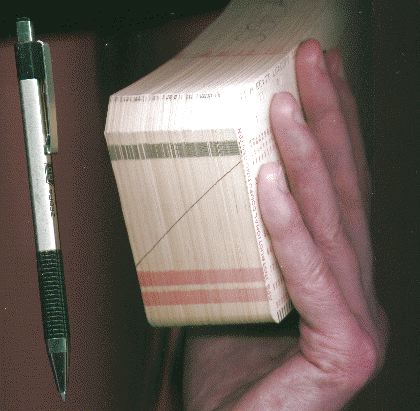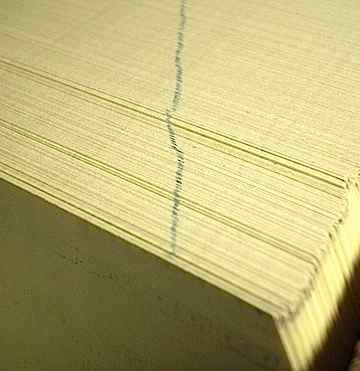|
If it’s vital that your cards stay in order, we strongly recommend that you stripe your cards. This was a standard technique in the days of punch cards.
How to do it: Using a pen and a straightedge, draw a diagonal line across the top or end of the deck. This ensures that the cards won’t get hopelessly out of order if they are dropped during shipping. The diagonal line will help us put the cards back in order if they get dropped or shuffled during shipping or handling.
Striping should leave a tiny dot on every card, and the position of that dot (from left to right) should reveal the position of the card in the deck (from front to back).
If we can’t easily determine each card’s order by looking at the dot on the card, the cards are improperly striped.
Wide, wavy, or jagged lines (such as lines made by a felt tip pen, or by refusing to use a ruler)
will be deemed improperly striped.
Legalese: While we make every effort not to be careless, we are not responsible for maintaining the ordering of unstriped or improperly striped cards.
 | ← | The right way.
|  | ← | Striped with a wide pencil and no ruler.
Bad, bad, bad.
|
Tips:
- Use a ballpoint pen with the finest point you can get. Do not use pencil (it smears over time); do not use felt-tip pens (ink will bleed out sideways, from card to card); do not work without a ruler. If your stripes are jagged or wavy or fuzzy, that’s practically as bad as not striping the cards at all.
- To straighten the deck before marking: Feather/fan the cards to get air into the deck, so the cards don’t stick together. Rap the deck sharply against either (a) a concrete pillar or floor or (b) a sturdy table, at the corner over the table leg. Rap the deck once on the bottom and once on the left end where you will draw the stripe; both surfaces should feel completely smooth, with no cards out of line. Lay the deck on its back, with the left end at the table’s edge. Hold the deck down firmly with one hand, hold a lightweight straightedge against the left end with your thumb, and ink the line using your other hand. Check that you inked all the cards -- the front and back ones sometimes get missed. Let ink dry.
Problems with this technique: Once you grip the deck from the back and front, you squeeze the air out, which makes it harder to straighten the cards. You might try splitting large decks into sections one inch thick: Stripe the sections separately, and use colored markers to mark each section a unique color, using color and/or position to distinguish the sections from one another.
Your best bets for keeping your cards in order are:
- Stripe them with a fine-point pen.
- Keep them in a locked drawer, safe from curious but unauthorized persons who might gawk at your cards and then place them back in the wrong order. Most of our orders show signs of this.
- If your cards contain index numbers (primary keys), don’t worry: our software catches all sequence errors, and we can sort them back into order for you.
- Reinforce your box: Glue the bottom flaps of your box together. Then fill your box with heavy books, and let it dry overnight. Reinforced boxes are stronger and can be stacked higher.
- Order one of our convenient shipping kits. Our box-in-bag-in-box system gives your cards three layers of protection, and contains your cards if the outer box is damaged during shipping.
Myths about Punch Cards:
Fun fact: According to urban legend, if you drop a stack of punch cards, they become hopelessly scrambled and shuffled. In my experience, this does not happen; you get a line of cards snaking around on the floor, but they remain in sequence, and most of the cards will remain in contact with their neighbors. Physicists say the Bernoulli Effect is the reason. In more detail: It takes much more force to pull two cards apart than to slide them against one another. So unless you drop your cards outdoors in a stiff breeze, or indoors near a high-powered air blower, it’s difficult to get punch cards out of order.

| Fancy Vintage Punch Cards are now for sale in our online store.
The perfect gift for techies and mad scientists.
|
Advanced Techniques:
→ For striping a whole box of cards, a better technique would have 2 lines of differing slopes: draw one long unbroken diagonal line from front to back of the deck/box, and then break up the box into decks about 2 inches thick, and give each deck a separate diagonal line; do not cross the lines. Reason for doing this: Diagonals of low slope can make it very difficult to figure out which cards go in which order; adjacent cards will get marked in very nearly the same place. So, lines of low slope mark only the rough location of each card. The lines with higher slope provide much better precision.

|




